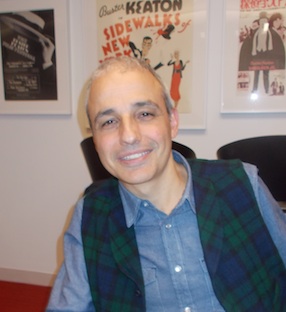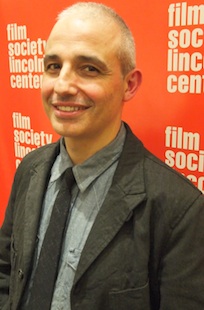Spanish
director Pablo Berger took a leap with his second film,
Blancanieves, in re-imagining of the Snow White fable
with enough grit to validate the film. However to construct it as a
silent film was a real jump into the abyss Ė both creatively and
financially. Keep in mind this Spanish director had the idea to do a
film this way nearly a decade before The Artist came out of
the French wilderness and won hearts, minds and the Oscar for Best
Picture in 2012.
Opening the
2012 Spanish Cinema Now Ė sponsored by the Film Society of Lincoln
Center Ė Blancanieves (Snow White), was Spain's 85th Academy
Awards submission to Best Foreign Language category this year, but
it didnít make the final shortlist. Playing on the Brother Grimm's
tale, it incorporates myth, archetypes and wry humor to tell a story
set in a romantic vision of 1920s Andalusia.
Intended as an homage to European silent
films, this twist on the fairy
tale is set in 1920s Seville and centered on a female bullfighter.
This film was
a huge hit in Spain and won the Special Jury Prize and Best Actress
"Silver Shell" Award for Macarena GarcŪa at the 2012 San SebastiŠn
International Film Festival. It also won 10 Goyas, including one for
Best Film at the 27th annual Spanish Awards.
Beautifully
shot, with an ensemble cast notable for their quiet finesse, it
entwines humor, betrayal, greed, deceit and sweet revenge as
fundamental story elements. When Berger came to NYC in advance of
its theatrical release he spoke lucidly about his film and his time
working in this city.
 What
did you need to learn to make this movie Ė this isnít what people
expect from a feature filmÖ.
What
did you need to learn to make this movie Ė this isnít what people
expect from a feature filmÖ.
My favorite
period of film history is the silent era Ė the 20s in particular Ė a
time when most types of cinema was invented. Most of the great films
from the silent era were made in the Ď20s. There are so many great
ones that Iíve been trained to follow or think of films
visually. Even when I went to film school, in the first year, I
concentrated on doing silent short films. When I was teaching at the
New York Academy my students did silent films. When you move to the
commercial world to make a black and white silent film, itís
expensive for Europeans, so itís like a cinematic terrorist attack.
It truly is and should be because the director should always
remember what makes film different from other media or art forms is
the visual story telling. Different shot sizes, camera movement,
lighting, the eye, even if you really think about it the moments in
film history that stay with you theyíre are very few that are
dialogue driven. They are these moments. I truly believe itís
visually driven.
How did you
cast Sofia [Oria]? How did you find her and how did you cast her?
What did you ask the actors to do that would be different from
normal?
In terms of
Carmencita, I was looking for a child that had some kind of magical
element. I was just looking for eyes. As a reference, I looked at
one of the great movies in Spanish film history called The Spirit
of the Beehive where the protagonist is this little girl who has
amazing eyes. When I talked to the casting director I said I was
looking for girls like that. We saw thousands of girls in Madrid,
Barcelona and Seville. There was a team searching in Spain to find
the girl. We were only one month away from shooting and had all the
famous actors but no Blancanieves. The two last people we cast in
the film were the two Blancanieves. This girl came as her first
audition, her first film audition. This is a girl who doesnít work
in movies but in theaters. I was so desperate that I called a friend
of mine, a theater teacher at school in Chile. Itís an activity not
a profession of kids that want to do it extracurricularly once a
week [there]. He told me ďI have one girl that I want you to see.Ē
It was her. Once she did the audition, we couldnít believe it. She
wouldnít blink, she was so centered and we were like, ďThatís her.Ē
Casting is a difficult process, itís not scientific. You see it and
thatís it.
It had to
be perfect because there the narrative wasnít driven by the
dialogue.
Yeah it had to
be someone magnetic and there had to be something about that person
that makes them unique -- whether you call it charisma or magic.
When you work with children, you donít direct them like professional
actors because theyíre not professional actors, they donít even act,
they just are and as a director, you have to be a facilitator. You
have to create the right environment so they feel protected,
comfortable and relaxed. Then the camera and me and the other actors
are just playing with them.
And the
other
Blancanieves?
The other
Blancanieves itís her first film too, she had worked on TV but this
is her first role. Itís not even a small film, itís her first role
and her first protagonist. I couldnít have a nine year old
Blancanieves that was amazing and magical and then when she became
18 to be like ďHmm not.Ē I was lucky to find this actress who had
the same qualities of the little girl Ė unique, charismatic,
magical. Her eyes are so powerful. The eyes are both young and they
talk to you. You get hypnotized. When I see them on the screen, the
teenager Blancanieves I donít think sheís acting. I think sheís
possessed by the character.
 Did
you have her train to be a matador? How did you direct her in doing
that?
Did
you have her train to be a matador? How did you direct her in doing
that?
It was about
one month of daily training, four or five hours a day. For both the
little girl and the older one because the little girl also had to do
learn how to bullfight. Itís not easy. Itís very difficult. You look
ridiculous. Itís very hard. Both girls were with professionals and
were training every day for a month. The father of Blancanieves too,
he had to be training.
Did you
worry about a backlash given the banning and restricting
bullfighting happening now?
Writers/directors canít be concerned about that kind of thing.
Nobody can be our censors of what stories we should tell or what
background. Iím not even a bullfight aficionado. Itís not
like I especially like bullfighting, I just thought it was the right
backdrop for this story. The origin of the film is this photo that I
saw in the early Ď90s about bullfighting. I put in the center of
this photo Snow White as a bullfighter and that was the image that
started it. So how could I make this film without a bullfighter
background? I wanted to make it a bullfighter Blancanieves. I didnít
want to make it the daughter of the king of Spain so at that time in
the early 20th century the only people who were so rich as the kings
were the bullfighters. In my case, heís the biggest bullfighter of
all times. Kind of like a mythical character.
Thereís
been a trend of re-imagining childrenís stories and you have done
your own modernized version...
The source of
filmmaking is storytelling. Thatís the most important part. Iím not
a film director, Iím a storyteller. I use film to tell my stories.
All these folk tales have passed the test of time because these
storytellers have hundreds of years. So only the good ones have
prevailed. Itís a great source and a great turning point and if you
had something that was only a few pages long, you have complete
freedom to create new characters, new plots, subplots until you make
it 90 pages. You donít even have to respect the author because the
author is not even the Grimms. The Grimms just tried to put it in
book form but itís oral tradition. So it says the Grimms tale but
the Grimms didnít write them. So Iím writing my version of this.
From a production point of view, theyíre public domain. I think
things happen like that. Sometimes comic books, some times
superheroes and right now they are adapting folk tales.
Was it a
concept, a choice to use the
Snow White
element to draw audiences in?
Itís true, I
didnít want to make an adaptation of Snow White. I wanted to
use the basic elements of the story for the key characters of my
film but I think my Snow White is a tale of tales. Thereís
Snow White, Cinderella, Sleeping Beauty. You have elements of
Lewis Carrollís Alice in Wonderland. You can add the gothic
novels. Thereís all these elements that Iíve put in because really
itís not an adaptation, itís a story with all these elements. I
wanted to surprise the audience and in the end that was my only
goal.
How was it
being the Oscar pick for your country?
I was the
Spanish entry which was super great. You canít win the best picture
but you donít have to be for the Oscars. We were selected but we
didnít make it to the final five. Iím fine doing the whole Oscar
rules but it feels fantastic. I have this permanent smile. When I
was up in the morning I smile and go Ė Pablo, you just woke up, you
cannot be sleeping with a smile. Itís been great for eight years.
Before this, I had eight years in a crisis because nobody wanted to
make this film. This is my second feature film. My first one
Torremonilos 73 was a success in Spain. I got four nominations,
dozens of awards internationally, it got a Chinese remake and a
release in America...
A Chinese
remake?
Iím very proud
of that. I felt a little like the King of the world but only for
five minutes because in 2005 when I brought the script for
Blancanieves to the producers, when they saw first page and it
said ďBlack & White, Silent, Big BudgetĒ they thought I was
absolutely crazy. So it took me eight years to get this off the
ground.
Did
The Artist
have anything to do with that?
No because
The Artist didnít get released eight years ago. By the time
The Artist was released my movie was already shot. Blancanieves
is not a reaction of a producer thinking, ďAhhh, The Artist
was a big hit.Ē When you choose to make a film, itís like a
marriage so you have to make those choices very carefully. Itís very
important that every film you make could be your last one so you
have to make that decision very carefully.
So how do
you follow this?
Iím traveling
all over the world with my megaphone saying Ė come see
Blancanieves. Since Toronto, Iíve been doing that and Iím happy
to be doing that. Iím the writer, Iím the director and the producer
of the film so Iím happy to. The life of success of an art house
movie is one year so when Toronto comes I finish. It took me eight
years, so I hope one of those projects turns out but I donít know
which one itís going to be.
Email
us Let us know what you
think.